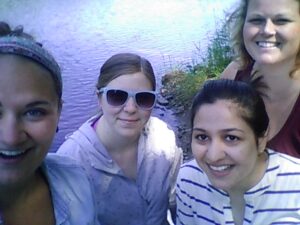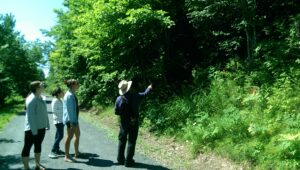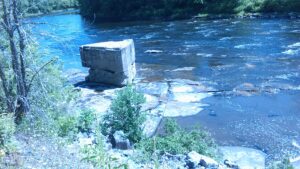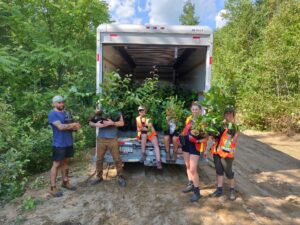On July 16, we — Olivia, Aliza and Karyn — traveled out to visit the Nashwaak watershed and learn more about river conservation and the work of the Nashwaak Watershed Association. We were excited for our first work adventure out of the office — a day on the water!
Stephanie Merrill, Freshwater Program Coordinator at the Conservation Council of New Brunswick, and also a board member of the watershed association, began our tour in Marysville along the banks of the beautiful Nashwaak River. Here we became more familiar with what Stephanie’s work and volunteer efforts consists of! She communicates water issues with the public and policy-makers and works with community groups like watershed associations such as the Nashwaak Watershed Association (NWAI).
Stephanie told us about a couple of key issues concerning groups who are working to protect our provincial waterways. We learned about the provincial Water Classification Program, which was developed by the Department of Environment and watershed groups to set water quality standards for rivers in New Brunswick, but which has yet to be enforced by the Department. Stephanie also mentioned the steady decline of salmon returning from the ocean, a worrisome trend that’s been going on since the mid ’70s due to a number of reasons like warming waters from climate change, sea lice impacts on migrating populations, and degradation of spawning habitat. We finished this section of our tour with an attempt at a group selfie with the Nashwaak. Too bad we didn’t have a selfie stick.

Our next stop was to visit NWAI president, Paul McLaughlin. We learned a brief overview about what they are doing at the association and the tree nursery which we would be visiting later. We took a walk down the Sentier NB Trail that travels directly along the Nashwaak. Here we learned more about the area’s history, the difference between red maple, sugar maple and silver maple as well as the classification of many other trees. Sugar maple are the trees you tap for syrup… cool! We also discovered many baby silver maples we are going to transplant for the nursery.

After a quick stop for a bite to eat we continued our tour along the Nashwaak, journeying to the NWAI tree nursery. We travelled just north of Durham Bridge to Sandra Estey’s land, locally called the McLean Flat. Sandra has graciously partnered with NWAI to use her property to house the nursery and demonstration site for outplanting from the nursery to the river bank. The nursery has a large supply of various sized saplings that are available for anyone along the Nashwaak to plant near eroding stream banks to help preserve the integrity of the bank. Also, if you need professional advice on species, site selection, planting and maintenance, the NWAI can provide you with that! Stabilizing the riverbanks helps to prevent sediment from settling into the river and also maintains water temperature and oxygen levels — all very important components of good salmon habitat and spawning conditions!
The tree nursery houses almost 5,000 seedlings reaching up to five feet in height! Almost 500 new seedlings are added each year from native hardwood and softwood seeds and cuttings collected in the area. Each year the plants rotate beds and after four years are ready to be planted by the river. The older trees are best for planting as they are more successful at surviving the transplant and will be able to withstand the pressures of flooding and moving ice seen each spring along the river.

The nursery and river planting program goes hand-in-hand with the association’s work to set up a greenway within the watershed. It would be the first greenway officially established in the Fredericton area; a publicly-held forest, trail and wetland area that would be maintained for its natural landscape. As an in-tact forested wetland, it would help reduce flooding, improve air quality, lower the summer water temperatures, prevent soil erosion and provide habitat for wildlife. The restoration of these forested wetlands will also offer savings to the city in terms of services such as water filtration, flood mitigation, carbon storage to capture greenhouse gases, maintaining moderate temperatures and controlling erosion (as compared with engineered devices that cost millions to the city). It also provides recreational opportunities like hiking, bird watching and more. What a great idea!
One topic both Stephanie and Paul talked a lot about was the provincial Water Classification program. We learned the various roles CCNB and NWAI have undertaken since the legislation was adopted in 2001. The legislation, under the Clean Water Act, aimed to collect, analyze and classify the state of water quality within the Nashwaak watershed and other rivers around the province. The water quality classification was to then inform the goals (based on current and future land and water uses) and priorities of communities along the rivers. It was intended that once an agreement is made on the future water quality goals, the class for each stage of the river will be set and water quality will be regulated by legislation, along with an action plan for maintaining or improving that water quality.

Unfortunately the project has been stalled since its introduction in 2003. Paul tells us he is disappointed the Department of Environment has not acted on the work his association did under the program, now more than 10 years later. Stephanie says the Water Classification program is a key tool to help protect New Brunswick’s waterways and ensure healthy waters into the future. She says the province has all the powers necessary to move the current river classifications into law. We sure hope that happens!
We had an excellent day out of the office and would like to thank Paul and Stephanie for taking us on this exciting Nashwaak adventure. Next time we will be sure to bring our swim suits!

